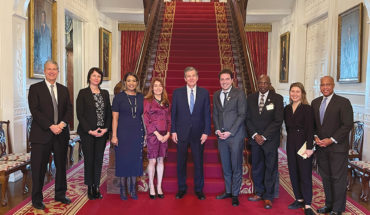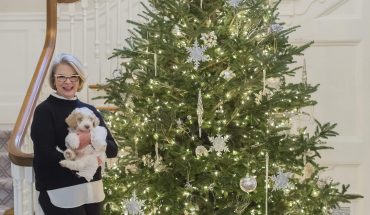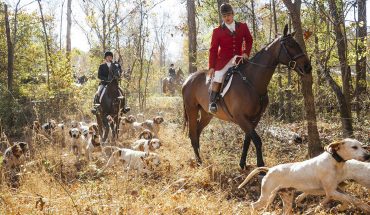
A panoramic view of the wetlands near Raleigh Boulevard. This stretch of greenway features a gazebo and more than a quarter-mile of boardwalk. It is home to beavers, deer, turtles, heron, ducks and the occasional fox.
by Scott Huler
photographs by Travis Long
Stand still.
What do you hear? Maybe a dog barking. Birds. The rustle of the wind in the trees. The slip of water streaming by – maybe, if it’s been rainy, you hear it rippling over rocks or fallen trees.
The point is, you don’t hear cars. You don’t hear city noise. You are surrounded by nature. Yet you are probably no more than 15 yards from a road, perhaps a main one. And you are minutes from your home – a 10-minute walk or two-minute bike ride. You are somewhere along the Raleigh greenway system, and if ever a city made a virtue of necessity, Raleigh has done so with its greenways.
More than a hundred miles of trails, many more miles than that of undisturbed wetlands, thousands of acres of green space saved for – well, saved for what? If you say for bike riding, dog walking, jogging, and other recreation, you’re right. But that’s just one of the reasons to love the greenway system for which Raleigh is loudly and justly praised. There’s a lot more to it than that, and to understand it all you need to go back to the beginning – to the very birth of the modern greenway concept, which took place right here in Raleigh, about 1970. Bill Flournoy Jr., the president of the Triangle Greenways Council, was there.
He was a graduate student at N.C. State’s School of Design, and the city was growing rapidly. It had 118,000 people and was terrified at the prospect of booming, over the next 10 years, to an almost unimaginable 187,000. City leaders feared for where those throngs would fill their leisure time, and how the city would retain its greenery and open spaces.
To consider all that, the city council and the parks and recreation advisory commission had a summer intern, William Blosser, research and write a document. That document, presented to the council in 1970, was called “Raleigh: The Park With a City in It,” and it advocated something remarkable: “This study has found that the natural features of Raleigh make it economically sound and financially realistic…to create a network of parks (and) green open spaces…(that) can enhance Raleigh’s already distinctive environment and insure…adequate recreation facilities for the future.”
A network of parks and green open spaces that “might be named the Capital City Greenway.” Flournoy says the greenways, naturally, were designed to follow the city’s two major creeks – Crabtree and Walnut. Those needed to remain open to manage stormwater. And since sewer lines, powered by gravity, tend to follow natural drainage basins, sewer rights of way would themselves provide greenway open space – which would serve many purposes beyond recreation.

Bill Flournoy, president of the Triangle Greenways Council, on the suspension bridge spanning the Neuse River Trail. The bridge is near Horseshoe Farm Park off Louisburg Road.
These green open spaces would dissipate heat, provide habitat for birds and animals, and maintain wetlands to buffer creeks. The city in 1971 used a grant to pay Flournoy to create a report called the “Capital City Greenway,” which outlined 11 different greenway objectives, from flood prevention to improved urban planning to wildlife corridors to mixed-use development – and, oh yes, to introduce a trail system. It’s considered the first citywide greenway system in the nation, all the more remarkable given that in the early 1970s Raleigh was anything but a progressive hotbed.
“The city then had a very business-friendly council,” Flournoy says. “And that goes beyond just having growth as a priority – it was what they were there to do.” That council stifled anything that got in the way of development, he says – “They didn’t want anything like floodplain regulations.” But the Crabtree Valley Mall, opened in 1972, quickly and regularly flooded; that, along with the growing environmental movement and action by political and conservation groups, got the city on board. In 1974 the city began purchasing land and building its greenways.
“Bill was the original planner,” says Vic Lebsock, currently senior greenway planner for Raleigh. “He had the big vision. I’m kind of like the blue-collar worker, making the thing work.” And work it has. Lebsock has worked for more than 20 years, taking the system from a few disparate trails in flood plains to a connected system of more than 100 miles – with close to a dozen more scheduled to come on in coming years – and some 4,000 acres of managed greenway space.
When Lebstock started as greenway planner in the 1980s, the focus was on building more and longer individual trails. “The emphasis today is on tying up those loose ends,” he says.

Randy King and his dog Cayla rest along the Capital Area Greenway near the N.C. Museum of Art. Brian Durkin of Raleigh rides past on his mountain bike. There are several art installations along the section of greenway, including a gigantic whirlyigig by Vollis Simpson, seen here in the background.

A turtle swims under a walkway that traverses a wetland segment of the greenway’s Crabtree Creek Trail. A flowering volunteer blooms on a submerged tree stump nearby. This quarter-mile-plus stretch of walkway near Raleigh Boulevard is a great place to spot urban wildlife including ducks, deer, wading birds, and the occasional fox.
In recent years, the House Creek Trail has opened, connecting the Crabtree and Walnut creek trails roughly along the route of the Beltline or Blue Ridge Road. The city has also connected the Walnut Creek Trail with the new 28-mile Neuse Creek Trail, which will connect with the Crabtree Creek trail by the end of the summer, enabling a biker to ride more than 30 miles in a loop around downtown Raleigh with only the briefest emergences from paved trails along the creeks.
What is amazing is that if you open that 1970 document, the earliest, roughest sketches of what the greenways would look like envisioned that loop.
Other parts have connected, too. The Mine Creek Trail leads from the Shelley Lake loop – which is probably the system’s busiest segment, with about 750,000 users per year – down to the Crabtree Creek Trail. The Rocky Branch Trail connects the Dix property to the Walnut Creek Trail. And soon, the Crabtree Creek Trail will make its way all the way to Umstead Park, where users will be able to connect with the Reedy Creek Trail and make an even longer loop around downtown. Longtime greenway activist Sig Hutchinson has called that missing piece “the holy grail.”

Katherine Manweiler relaxes in a hammock with friend Priyanka Venkannagari on the Capital Area Greenway near Enloe High School. Often only feet from urban bustle, the greenway offers a quick escape into natural forest settings.
When the city completes a trail from the Crabtree Creek Trail into downtown, the greenway will then connect not only to both the northern and southern main trail networks but to virtually every quarter of the city. In Bill Flournoy’s original document, one of the 11 goals of the system was to “give alternative to the automobile for short commuter trips.” Even the original paper that started it all dared to hope that “eventually, a Raleigh citizen might walk or ride his bicycle … to almost any part of the city.”
The realization of that dream has rippled outward: Knightdale and Clayton have connected trails to our greenway system, and trails maintained by the state, like the Mountains-to-Sea Trail, and by the nation, like the East Coast Greenway – include stretches of our greenway.
Yet for all that, the greenway still serves its primary purposes best. It provides wetlands to filter water and cool the city and green spaces for animals and birds. “On Buckeye Trail (the first greenway trail built, now a segment of the Crabtree Creek Trail) I’ve seen pileated woodpeckers,” says John Dancy-Jones, a retired environmental education teacher who blogs about Raleigh’s natural environment. “They’re so huge and beautiful.”
Above all, the greenway is a place for city dwellers – nearly half a million now – to slip away from the city and into the wild, to find minutes from home a natural environment that predates and will outlast us all.
The artist: Autumn Cobeland
It took artist Autumn Cobeland, above, a long time to discover the greenways. A Raleighite by birth and choice, she has traveled the world, leaving for college, studying in Italy. “But I definitely feel like nothing compares to Raleigh,” she says in the studio she rents on the edge of Roanoke Park in Five Points. “I adore Raleigh.”
Throughout her career, people have told her what people always tell artists: “Paint what you know…paint what you love.”
“Van Gogh painted his room,” she says; Monet painted those water lilies. But she couldn’t see herself painting postcard-style love letters to the NCSU bell tower, the state capitol, or Memorial Auditorium.
Then in 2009 she started training for a sprint triathlon, and she found herself running and biking on greenway trails. “I grew up near Jaycee Park…but it really took getting on my bicycle and doing it to realize just how spectacular it is.”
Influenced by lithography and posters by artists like Toulouse-Lautrec, Cobeland, 39, started taking pictures of the trails, finding angles that spoke to her, and for want of a better word, posterizing them. She uses a simple photo manipulation program to do a quick, splashy transmogrification of her photos, then paints over printouts to explore what she’d like to do. When she knows where she’s headed, she sketches out the large painting on paperboard, then creates it using watercolor and gouache.
Sometimes the images are expansive – a lovely view of the pedestrian bridge over the Beltline; the moon rising over Rothgeb Park. Other times she focuses on details – turtles on a log, an egret over a stump. In all cases the bright colors and stylized “greenway” caption make the paintings more than mere representation. They become sort of travel posters for the greenway’s secret highways. She has shown the originals and prints at the Visual Art Exchange, the Block Gallery in City Hall, and Margaux’s Restaurant, and sells poster prints at stores like Deco and NOFO.
If her paintings feel, as travel posters often do, like love letters to a place, that’s fitting: Cobeland donates 20 percent of her proceeds to the city’s Parks, Recreation, and Cultural Resources Department and the Triangle Greenway Council.
“There’s this weird sense of pride,” she says of the trails that inspire her work. “I’m so proud of Raleigh for putting its resources into something that everyone can enjoy.”
Go to autumncobelandpaintings.com
The die-hard: Bill Krueger
However much you love the Raleigh greenway system, you haven’t seen as much of it as Bill Krueger has.
“I’m probably at about 90 percent,” he says of the system’s more than 100 miles of trails that he has walked or biked. “Maybe even 95…I did a long stretch a week ago on Neuse River.” The 28-mile Neuse River Trail is not even quite completed: Krueger means business. Even though, as he says himself, “I’ve been a late entry in terms of discovering it.”
Krueger, 55, spent decades as a staffer at The News & Observer and now works for N.C. State’s alumni magazine. He also ocassionally writes for this magazine (see My Town, pg. 73). He lives near the N.C. Museum of Art, and when the pedestrian bridge over the Beltline opened in 2005, connecting the museum grounds and the Reedy Creek Trail with Meredith College and the Walnut Creek Trail that runs along the southern edge of downtown, the greenway suddenly seemed to open up to him.
“I didn’t want to keep seeing the same scene,” he says. “So bit by bit I tried to explore a little more. Every time I explored a new area I enjoyed it, so I said, ‘what else is out there?’ and just decided one day it would be interesting to try to do the whole thing.”
The information is out there. He loves the city-produced free greenway map, but he also relies on the free RGreenway smartphone app developed in 2012 as a result of CityCamp Raleigh. “It can pinpoint where you are,” he says. “There are a few spots where signage is either unclear or nonexistent.”
Given recent greenway connections, he has been able to do more and more. The House Creek Trail, which runs parallel to the Beltline from Meredith College to the Crabtree Valley Mall, means that with few exceptions he can reach every inch of the greenway trails on foot. Of course he still drives to far-off spots on the trail, and sometimes that’s a losing proposition. The Neuse River Trail extends all the way to the Johnston County line, for example, and he and his wife “had to drive a half hour to walk five or six miles. That’s not very efficient.”
In fact, it’s almost missing the point. The whole idea of the greenway system is that you don’t have to leave the neighborhood to go into the wild. “You can be right in the heart of the city and it takes you very quickly back into nature.”
He mentions a stretch of the Walnut Creek Trail, “near Pullen Park back into town past the Dix Property. You’re about five yards from Western Boulevard. You can hear the cars… and there’s this beautiful creek down there. You’re enjoying something that people just a few steps away aren’t enjoying. If they just stepped out of their cars and took the time…”





